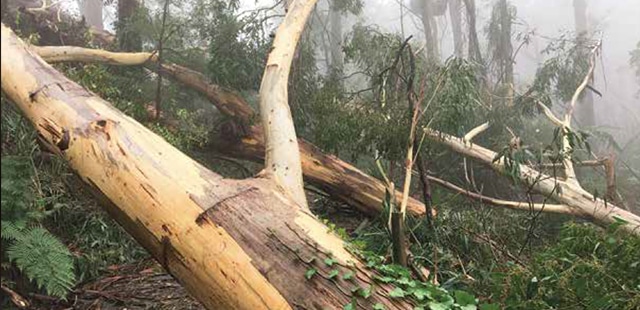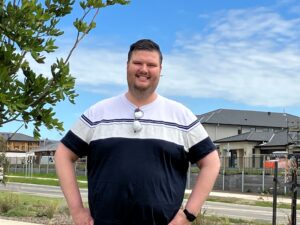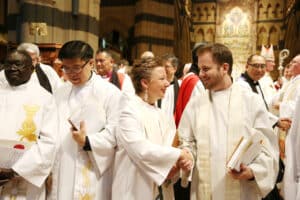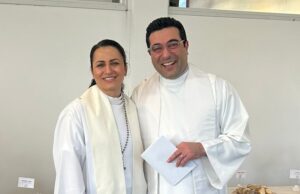Anglican churches have rallied to help disaster-stricken areas in Mt Dandenong, the Macedon Ranges and Gippsland

By Stephen Cauchi
9 July 2021
Anglican churches throughout the Melbourne diocese have rallied to help disaster-stricken areas in Mt Dandenong, the Macedon Ranges and Gippsland following wild storms and flooding that hit Victoria last month.
Churches around Mt Dandenong spearheaded a local relief effort in the wake of massive damage caused by falling trees, including dozens of destroyed homes and a wrecked electricity grid that has yet to be fully restored.
The Vicar of the Anglican Parish of Mt Dandenong, the Revd Andrew Smith, described the impact of the storm on 9 June as “extraordinarily traumatic”.
In Kalorama, which he described as the storm’s epicenter, there were “36 houses totally destroyed and then about 125 houses that are damaged and need serious repairs”.
Within the block around the church and vicarage in Kalorama, there were “eight to 10 houses destroyed and as many again that are seriously damaged”. Parishioners’ homes were among those destroyed.
On the afternoon of the storm, he said he could only drive 250 metres before the amount of flying debris forced him back.
“It got worse and it just went on all night. And it was just a loud roar,” Mr Smith told TMA.
“What we could hear was the sound of trees falling and the ground shaking. These are trees big enough to shake the ground when they fall, they’re enormous trees.
“The vicarage was OK but the sound all night was of trees falling, snapping in the wind, hitting the ground.
“That’s the terrifying sound that’s traumatising people now.”
Mr Smith said there was a loud crash at 3am, which “… was one of our trees in the front yard going onto the neighbour’s front porch”. “They weren’t hurt,” he said.
“Two doors along from us there’s a house that’s destroyed with a big tree through it and about two doors along there’s another two houses that are completely destroyed.
“Across the road there would be at least five that are damaged badly at the back with trees through them and another two on the side road that are destroyed.
“Some trees just snapped off halfway up – it’s extraordinary to see the force that must have done that. Others have gone over at the base.”
Some of trees that fell were two metres wide, he said.
Mr Smith said he’d heard stories of people moving to a different room just before a tree fell on it, or a tree that “went within inches of our child’s bedroom”.
Some residents “said their goodbyes … they didn’t think they would survive the night”.
The trauma of having nearly died was “pretty widespread”, he said.
“I’m talking to families where children don’t want to sleep if it’s raining, or if the wind’s blowing.”
In addition to the wind, about 271 millimetres of rain fell on the night of the storm.
The shock of realising there was no electricity, heating, phone or Internet was compounded by the lack of response from emergency services and the Government.
“We realised that actually apart from the local Country Fire Authority (CFA), we hadn’t seen anybody, heard from anyone, we had no phone, no Internet, no way of communicating with anybody and it occurred to us that we were just on our own and nobody knew what was going on here,” Mr Smith said.
“There was just silence and the sound of chainsaws. Nobody was coming.”
For the first week, there was no Internet and very poor mobile reception. “It was almost impossible for us to communicate in any way off the mountain.”
Mr Smith said it was Friday afternoon – two days after the storm – “before we saw anyone other than the CFA”.
The church immediately began its relief effort.
“We pitched in with them (CFA) and started providing meals, knocking on doors and making sure we could get people who needed to be warm, warm and fed,” he said.
Although the church’s electricity was out, it had functioning gas heating and a gas stove. The church was subsequently left open so residents could be warm, comfortable and fed.
The church then also served as a soup kitchen and a collection point for groceries and blankets. It was now “a mountain of groceries and a giant food pantry,” Mr Smith said. The church also provided generators.
“One woman said: ‘It’s not that you got me a generator, it’s just knowing that after all of these days of being cold that there are people who care.”
Churches throughout the diocese had pitched in to help.
“The Church has rallied brilliantly,” Mr Smith said. “We’ve been getting calls and offers of support from churches all over the diocese – as far as Ocean Grove and all of the city and down the Mornington Peninsula. That’s been fantastic and the generosity has been really, really good.”
Businesses from Bunnings and Samsonite to a local Indian restaurant had all pitched in with free goods.
Mr Smith said the local community had been very grateful for the help of the Anglican Church.
“We were one of the first groups to respond and help and offer support,” he said.
“Some people are going, ‘Well, actually, church is not what we thought it was, and actually these people are really practical and generous and loving and there’s no conditions – they’re not saying we will help you if you start coming to church’.”
Other Christians, including the Salvation Army, had also contributed to the relief effort.
“It was noticeable in the early days of this that actually the people responding was the church.”
With no electricity until at least 10 July – and perhaps 24 July or later – the community was in for a “long haul”, Mr Smith said.
“The electricity grid is totally destroyed. They’re not even trying to repair it, they are just building a new one.”
“Badly traumatised” residents now faced the challenges of dealing with insurance companies and finding new housing.
“There’s very little rental accommodation for average families on the hill (Mt Dandenong), so we’re trying to find it in nearby suburbs.
“My biggest concern (is) people’s mental health is really starting to struggle now through exhaustion and just through the overwhelming task of cleaning this up.”
Reports of looting were feeding people’s anxiety, as were fears more trees would fall.
He described the Government response to the disaster as “good when it eventually happened”, but said the community had been angered by the lack of visits from politicians.
“There’s been no one from the State or Federal Government come to the worst-affected area of this disaster. We’re two weeks on and still nobody has come.
“There was a really strong sense of anger, particularly in the first week, that the people in the Dandenong Ranges, and particularly Kalorama, didn’t matter to the Government, that we’re not important.
“There has been very bad communication between the Government and the local community …. and there is a fairly reasonable level of anger about that.
“There is quite a sense of disbelief up here that nobody knew what had happened up here when we are so close to the edge of Melbourne.”
Mr Smith said the fact that no one had died was “the biggest thanksgiving for the whole event”.
Bishop Paul Barker, who visited the Mt Dandenong and Mr Smith, said that “even though I’d seen news reports, it was much worse than I’d expected”.
“Up at Kalorama, the trees that have come down are massive. They’re very big Mountain Ash, very tall.”
He said he had toured one man’s demolished house. “I had a look at his house and his lounge room is just demolished. You walk in through the front door and the lounge room is sodden, everything’s a mess, destroyed – and there’s a big tree that lies through the lounge room.”
The Anglican Parish of Mt Dandenong was “doing an amazing job … drop-in centre, food, soup, Wi-Fi centre, they’ve got NBN up and running, they’ve lent generators”.
Bishop Barker also praised the response from other churches. “Several churches have given or provided significant things … there’s three or four carloads/vanloads from at least two churches.”
Another church has given $1000.
“People’s response has been quick and very generous it’s been wonderful.”
Neighbouring churches were quick to help. The Vicar of Croydon Hills and Wonga Park Anglican Church, the Revd Leroy Coote, said his church had taken “at least four loads up of supplies to the Dandenongs to meet the needs of people and two generators”.
“Our church has supplied plenty and we’re only a little church and (to) put it mildly, we’ve punched above our weight,” he told TMA.
“Other churches are now coming on board, too.”
Mr Coote described the damage in the Dandenongs as “horrendous”, with massive trees completely uprooted. “Houses have been crushed, there are trees through the middle of those, there are trees everywhere on the street.
“Trees that were healthy in foliage are basically just long stumps.”
He said non-perishable food was particularly in demand because the lack of electricity on the mountain meant fridges weren’t working.
The church had provided “lots of long-life milk (and) tea and coffee”. “We’ve even catered for gluten-free people as well.”
Blankets had also been donated “because it’s cold up there.”
Croydon Hills itself had been without power for five days. “A lot of trees down. Nothing in terms of taking down houses that we’re aware of.”
The Revd Janice O’Gorman, Vicar of St James and St Peter Anglican Church in Kilsyth-Montrose, said the church had regained its power before many of her parishioners.
“So I opened the church up for charging, Wi-Fi, getting warm … and then liaised with people to start supplying dry firewood,” Ms O’Gorman told TMA.
“So we’ve been doing dry firewood, we’ve been doing food, we’ve been doing candles – things for light, things for heat, blankets.”
As power had been restored to her parish, the focus was now on sending firewood and supplies to the Mt Dandenong parish.
“We’re getting regular people going up and I’m coordinating people who want to give large donations.”
She described the damage as “pretty bad”.
“According to the weather people, it was Montrose, Kilsyth, Mooroolbark, Mt Evelyn and Kalorama and Mt Dandenong and Olinda that got the worst of it and I believe that.
“I went up as soon as I could, which was the Monday, and I was driving around the ends of trees and it was pretty bad the amount of stuff that was all over the place. You could get through the road but it wasn’t safe at all.
“There’s lots of people who are staying with their neighbours and other things and a lot of people who can’t drive because their cars are under trees. They’ve been squashed.
“So a lot of people are walking to the relief stations and a lot of people are quite stressed of course because it’s going to be weeks before they get their power back.”
MACEDON RANGES
The Vicar of the Anglican Parish of Gisborne, the Revd Dennis Webster, said Macedon, particularly Upper Macedon, had been very hard hit by last month’s storm.
“We still can’t get through to the top of the mountain … we’re getting a lot of trees still coming down,” Mr Webster said.
Woodend and Kyneton had been “exceptionally hard hit”, while “Lancefield and Romsey were without power for days”.
“We had a bit of damage out here … many days without power, we still have parts of the parish inaccessible.”
“We’re just a bit concerned about the rain at the moment because that’s likely to destabilise more trees and maybe lead to other power breaks.”
Mr Webster described the mood of the community as “resilient”.
“Everybody as a community is responding well and doing what they can to support one another.
“Through our food centre, we’re making sure that people have got what they need. The op shops are providing any extra clothing as required.”
One parishioner sourced a generator for a family that needed power for medical purposes, he said.
GIPPSLAND
Bishop Richard Treloar of Gippsland described the flooding in the region last month as “devastating”.
“I’ve been able to drive out and about a little bit and just see some of the devastation and the flooding first-hand and it’s pretty dramatic in places,” Bishop Treloar told TMA.
“For Gippslanders, the recent kind of flooding and wild weather just compounds the challenges of the last 18 months, with bushfires and COVID.
“So there’s been a series of threats to lives and livelihoods that really test everyone’s resilience and has a level of cumulative effect on people’s health and wellbeing as well as their property and their income.
“People have lost fridges, freezers full of food and farmers have lost fences and stock and crops.
“There’s been incredible amounts of disruption with school closures and workplace closures and people being flooded in or flooded out.”
As with Gippsland’s bushfires in 2019-20, the flooding had been “pretty confronting and pretty traumatising”.
“There’s a long lag to it in terms of cleaning up and restoring infrastructure and tidying up debris and so forth,” he said.
“It came on us very suddenly but thankfully we’ve been able to respond quickly through the networks we have on the ground, through the parishes and other partners in mission.”
Gippsland’s parishes had been “really reaching out with direct help, relying on the local clergy to advise (on) any immediate pastoral or emerging support needs”.
Churches sustained water damage and storm damage, particularly around Wellington Shire, but also in Traralgon, the Latrobe Valley and Morwell, Maffra, Sale Cathedral, Corner Inlet, Rosedale and South Gippsland. Gippsland Grammar also received water damage.
“It seems as though four or five of our parish churches have sustained damage, as well as some other ancillary properties – op shops and rectories and halls and things.”







